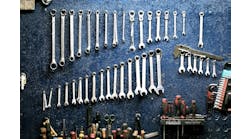I can recall a conversation with a shop owner not that long ago in which we were discussing a slump in his business performance. The excuse was fairly common: “Mike, it’s simple. My phones just aren’t ringing, and I need cars.” After several comments back of, “Yes, of course; I have a procedure for that” the shop owner snipped back, “Mike, listen. I know what to do. It’s not a matter of knowing what to do. It is simply a matter of when. You don’t understand, I just don’t have any time. It’s the constant interruptions!”
I won’t go into all the details of the remainder of the conversation, but I am sure you see the irony in the statements.
Ask a fellow shop owner about time and the universal truth you will likely hear is: “Time; are you nuts? I have no time.” Yet time may be the most valuable tool a shop owner or manager needs to invest in acquiring.
A few years ago, I read a book called Profit First by Mike Michalowicz. The premise and practical tools that the author shared had a huge impact on me and quite literally changed the way I considered what profit was and the order in which money needed to flow through my business. My financial model was transformed from an existence of “hand to mouth” and completely reactionary to realizing consistent and substantial regular profit.
Recently, I had the opportunity to listen to the author speak in person at an industry conference in San Antonio, Texas. Once again, I was struck with the simplicity of his message: The profit-first formula of sales minus profit equals expenses, which forces a business to be innovative and creative with managing expenses. If you put profit as the first allocation of income before expenses, then your business is forced to adjust and operate within the remaining income dollars left to pay your bills. Sounds easy, right? This simple formula follows the application of Parkinson’s Law, which, paraphrased, states: “Work expands to fill the time available for its completion.”
Why do I relate all this in an article about time? Well, as I listened to Mike speak, it struck me that the concepts he spoke about related to money and profits were equally, if not more importantly, applicable to the concept of time for a shop owner. I have been able to build and develop an exceptionally operational automotive repair business that does not require me to be “in it” on a daily basis. Working with shop owners all over the country who are trying to create the same for themselves, I’ve come to realize that the most valuable asset an owner or manager has is the ability to allocate the time necessary to properly utilize and maximize their potentials.
One constant in the universe is we all have the same amount of time available to use. There is no path to extra time. What you do have is the choice and control in how you allocate yourself to the time you have available:
- Be stingy. Learn how to say no to requests, demands and distractions. Realize that working on longer-term goals will always reward you far more than getting caught up in the seemingly always urgent issues and tasks of the moment. You should never pay a CEO to do $12 per hour work.
- Know your role and embrace it. Being an owner/manager isn’t about being the best at or doing every job in your business—it’s about developing and managing those with the talent, skill and time to be the best they can for your business.
- Trust your employees once you have trained them. Inspect what you expect doesn’t mean hover and micro-manage. Set clear standards, make sure your staff is trained in the role and understands your expectations, then simply manage through accountability and tracking.
- Be disciplined. Staying on task as an owner is hard. Especially when daily operational tasks are your comfort zone. “I’ll just jump in and help” or, “I can get this done quicker myself” are easy and comfortable ways out, but that leads to long-term failures. You de-skill and de-value those you have trained and entrusted to get the job done. Being busy, backed up and “under the gun” isn’t a bad thing. Respect them enough to let them have the victory of struggling through and succeeding or failing and learning what not to do next time.
- Be OK with being “wrong.” Teach your staff to be problem solvers and how to figure out the right solutions. Not always having to be right is the ultimate empowerment you can grant your staff. When you finally allow yourself to not always have the final decision or the final word, you grow your staff, the operational structure of the business and free yourself from the shackles of having to be “in It” every single minute of every single day.
Four action items that will help you (re)gain time and control:
1. Address the “Dad Syndrome” by instilling confidence and teaching your staff problem-solving skills. As we all know, it is a hard transition from technician/owner (or advisor) to truly being an owner of an operational and self-sufficient business. I found my staff constantly interrupting me with, “Hey, Mike; do you have a minute?” It felt like the harder I worked to help, the more dependent the staff became on me. Of course, I wanted to help them, but the more I gave them the answers the more dependent they became.
Then it dawned me. I was simply the “path of least resistance” and the quickest solution. I was deskilling them and stunting their growth as professionals and virtually ensuring that my business could not reach “operational status.” It took a lot of commitment and patience on my part to start asking questions and not just giving them the answer. I adapted a mentor’s mantra: “Please don’t come to me with a question or problem. Come to me when you have a solution and I will be more than happy to help you confirm if it is the best course of action.” It was hard to just listen and not offer my opinion, especially when I knew their solution may not have been optimal. My knee-jerk was to jump in and just give them the answer, but the magic was in simply asking the right questions to get them to come up with their own optimal solution.
Over time, their questions became statements and they were just looking for confirmation. Then almost like magic, they just stopped coming to me! They realized that I was just confirming what they already knew and the result was self-sufficient technicians (staff) that held themselves accountable for their own work. The takeaway: teach your staff critical thinking and decision-making skills by asking questions rather than just giving them the answer.
2. Identify your high value and important tasks. if all you have is short-term focus, you will constantly be reacting to things that are urgent, but not necessarily important. It is hard to pull away from the daily tasks that keep the business running, but isn’t that what your staff is for? Make a list of the tasks that you perform or should perform. Delegate what you can on the list and then streamline your list to tasks that will have the most impact on your business and are best suited to you as an owner.
3. Set a schedule for yourself and stick to it. Just as with the profit-first formula, allocate your “owner-time” as a resource (like money or profit) and make it a “first priority.” Learn the discipline you would expect from your team members and say “no” to distraction. Do a self-evaluation and determine when and how you are most productive. Maybe you are a morning person and need to get to work early before your staff arrives. Maybe you need to find a place with less distractions. Find what works for you and be disciplined enough to stick to it. Time management is essentially self-management. What you choose to give your attention to will determine the direction of your business and life.
4. Seek knowledge and implement it. I once heard a wise man say that knowledge is power, but success is only gained with execution. Learning the role and nuances of business ownership and leadership is a broad and ever-changing discipline. Great shop owners always seek knowledge and experience. Surround yourself with those who have succeeded in areas in which you wish to be successful. Push yourself to be better, learn to take risks and never be afraid to “take the shot.” You can only be successful once you actually take action.




